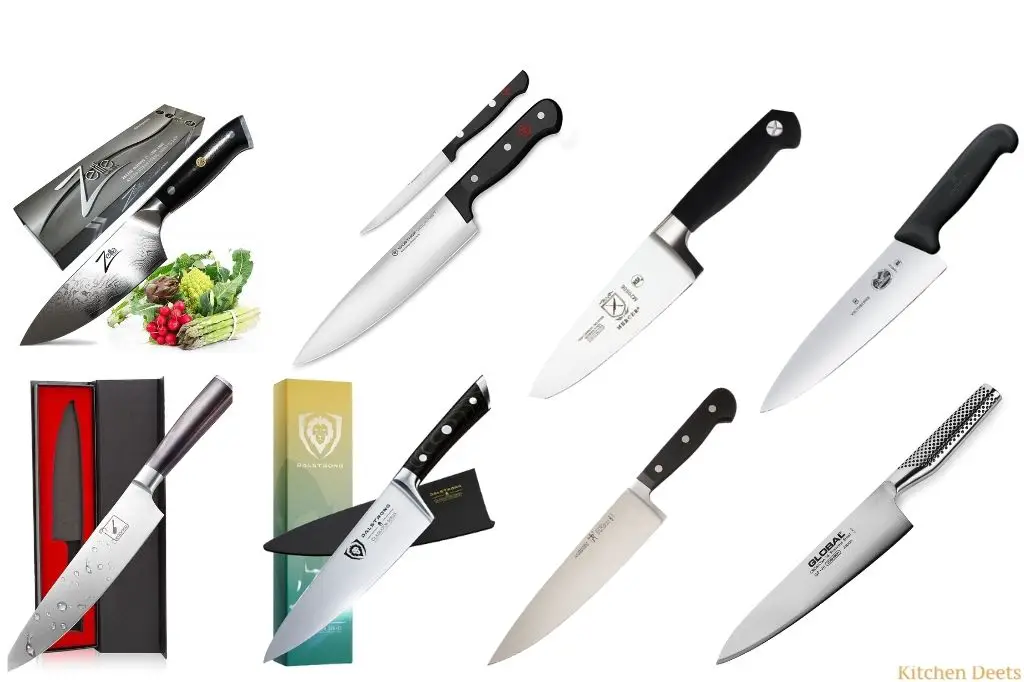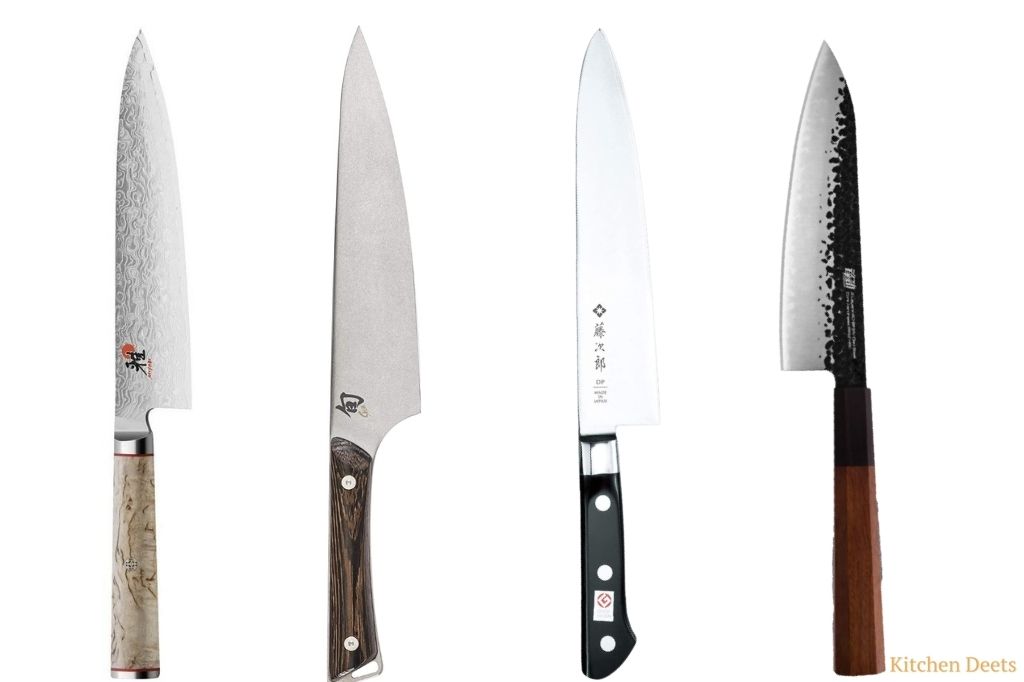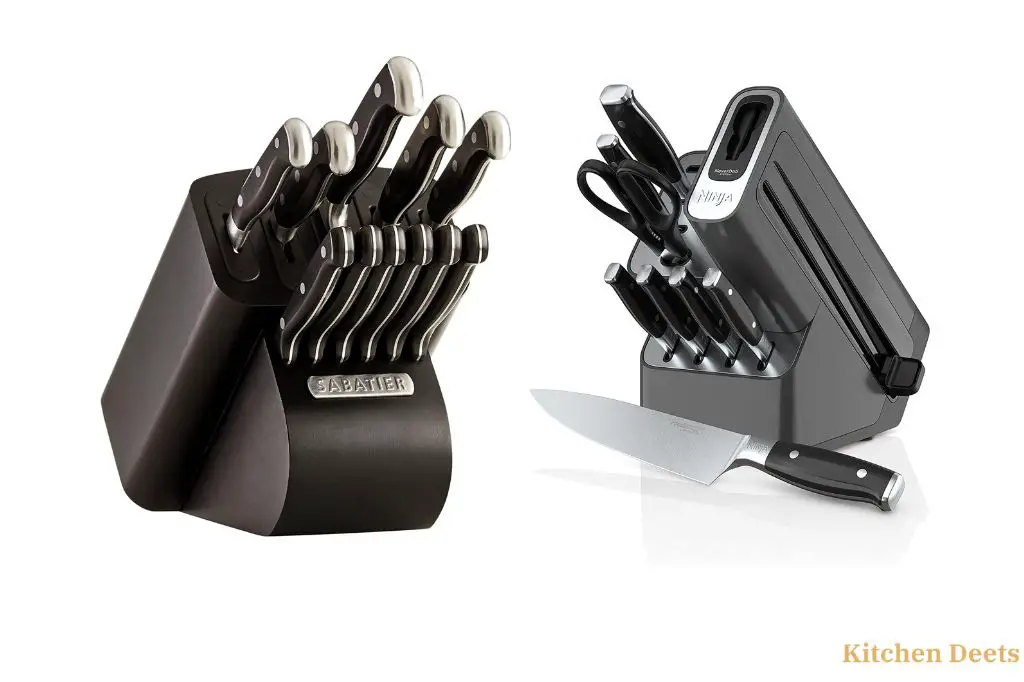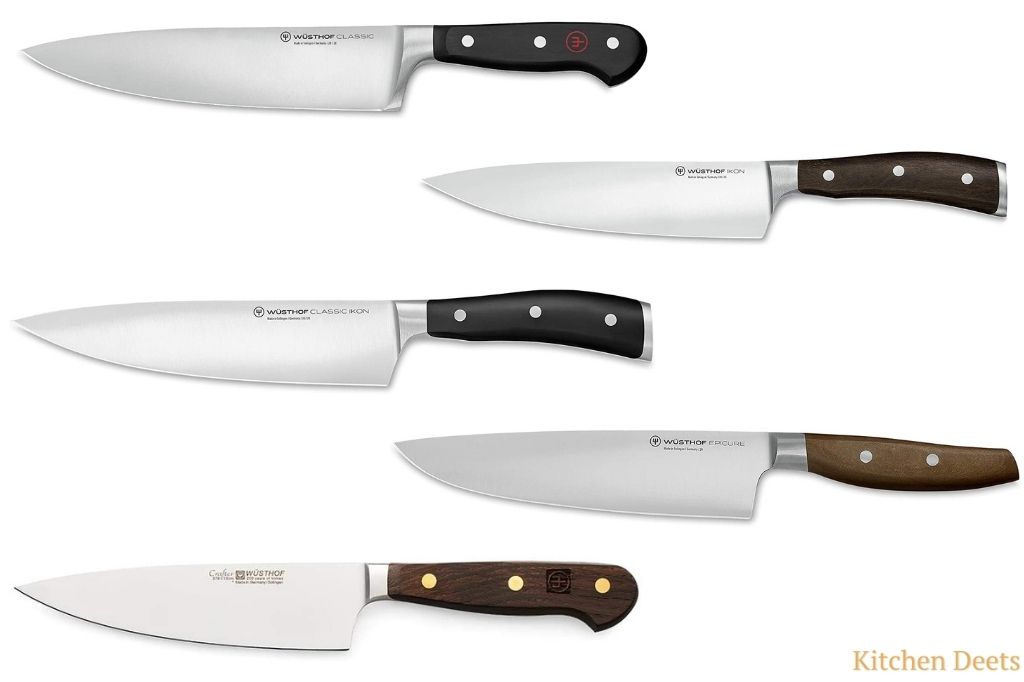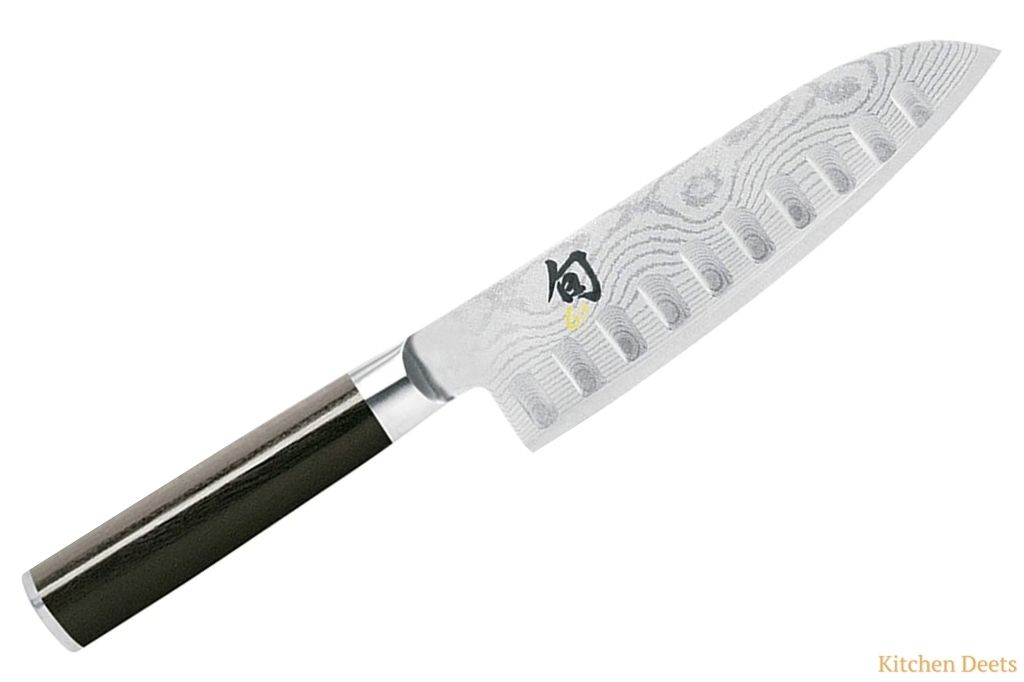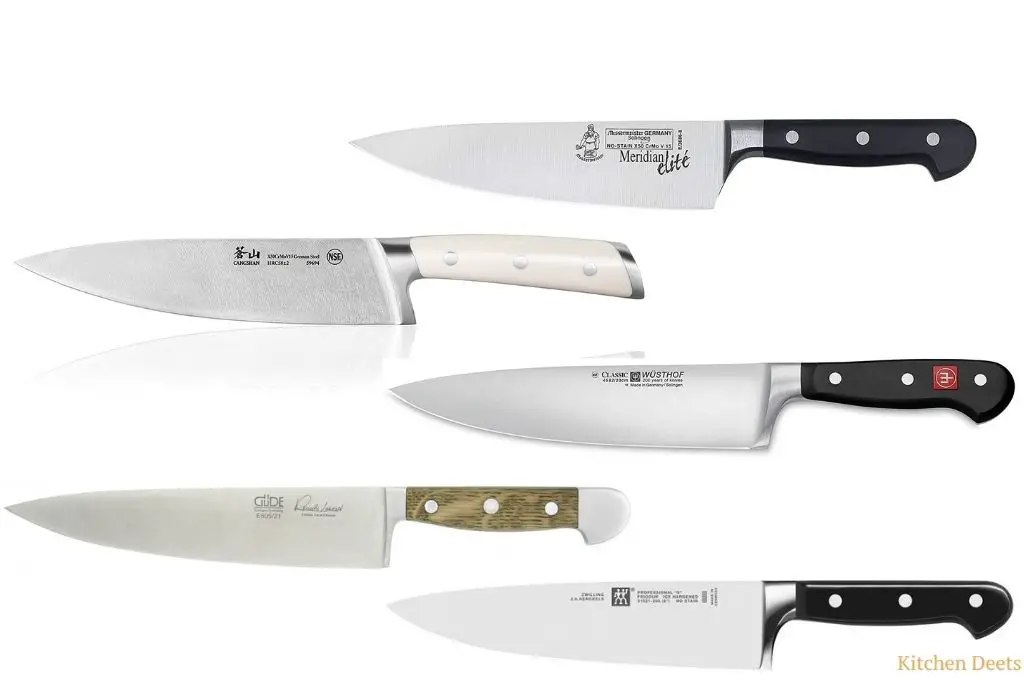A knife is one of the most necessary tools in every kitchen. We use it in almost every cooking task. Without a perfect cutlery set, your kitchen tools are incomplete. However, when it comes to buying affordable and best quality cutlery, there are often many doubts. But no worries! We provide you with the variety of best kitchen knives in 2022 available.
In this way, you can choose the knife that works best for you according to your cooking style, your hands’ size, and is easy to use within a small budget of $100!
We Picked The Best Kitchen Knives Available For You!
There are countless chef knives in the market, and so finding the best chef knife sometimes becomes difficult. Depending on Which features do you prioritize: the size of the blade? or the weight of the knife? There are all sorts of options, from small and light models to large and heavy ones. You have to pick the knife that fits your preferences and budget. But you don’t have to worry about it anymore. We spent weeks researching the knives recommended by most authentic chefs and tested their performance and durability.
As a result, we picked these top best kitchen knives from the most trusted brands for your kitchen and restaurant use to save your money and time!
List of Best Kitchen Knives in 2021
- Global 8-inch Oriental Knife
- Imarku 8-inch German Knife
- Zwilling J.A. Henkel’s 8 Inch International Classic Knife
- WÜSTHOF Gourmet Two Piece Cook’s Knife Set
- Mercer Culinary Genesis 6-Inch Knife
- Victorinox Fibrox Pro 8-inch Knife
- DALSTRONG 8-inch Knife – Gladiator Series
- Zelite Infinity 6 Inch Knife – Alpha-Royal Series
Global 8-inch Oriental Knife:

This best chef knife is one of the Asian’s styles knives. Western markets by Japan firstly introduced it. while its customers highly appreciated it. Because of its unified handle, there’s no possibility of handle breakage or damage like other knives with plastic or wooden handles, which is why we recommend you to spend your $$ on this durable knife.
A classic collection of large blade knives with the seamless melding of the handle to blade, the Global chef knife is one of the most suitable Japanese chef knife. It has small spaced holes in the steel handle for easy and strong grip and fits almost every size of your hand providing you perfect balance while cutting. There is a small finger notch at the end of the blade also so that you can easily control the knife during cutting without harming your fingers.
It is slightly higher at the tip of the knife with an extremely share edge and blade, due to which you can use it in almost every task from cutting and chopping vegetables to slicing and mincing large pieces of meat or fish.
Global 8-inch knife as the best chef knife is very famous among the best Global cutlery collection. It is lightweight, sharp, stylish, and just perfect for your kitchen counter.
As its blade has the finest stainless steel called CROMOVA 18 (made up of chromium, molybdenum and Vanadium), there’s no fear of rusting and no sharpening required for a long time of period. The edge of this best chef knife is sharpened to 15 degrees, which is why you can easily chop or cut vegetables or meat with little or almost no effort in quitter lesser time.
On a wider level, professional chefs use this best kitchen knife for cutting and chopping purposes because of its large and highly sharp blade. So if you want to attain the opportunity to buy this best chef knife and make your cutting just like professional chefs, book your order by clicking on the below-given buttons now!
Check out our review on Shun Knives
Pros:
- The knife is lightweight and easy to handle
- Round finger notch for safe cutting and sharpening
- A long sharp blade with a pointed edge for professional cutting
- The seamless handle ensures no damaging or repairing in future
- Resists rusts, stains, and corrosion issues because of high-quality stainless steel blade
- Lifetime warranty against defects and breakage
- The smooth contours and seamless construction eliminate food and dirt traps, offering safety and hygiene
Cons:
- No shielding cover
- A little risky to use for beginners because of the large blade
- Hand wash only
Imarku 8-inch German Knife:
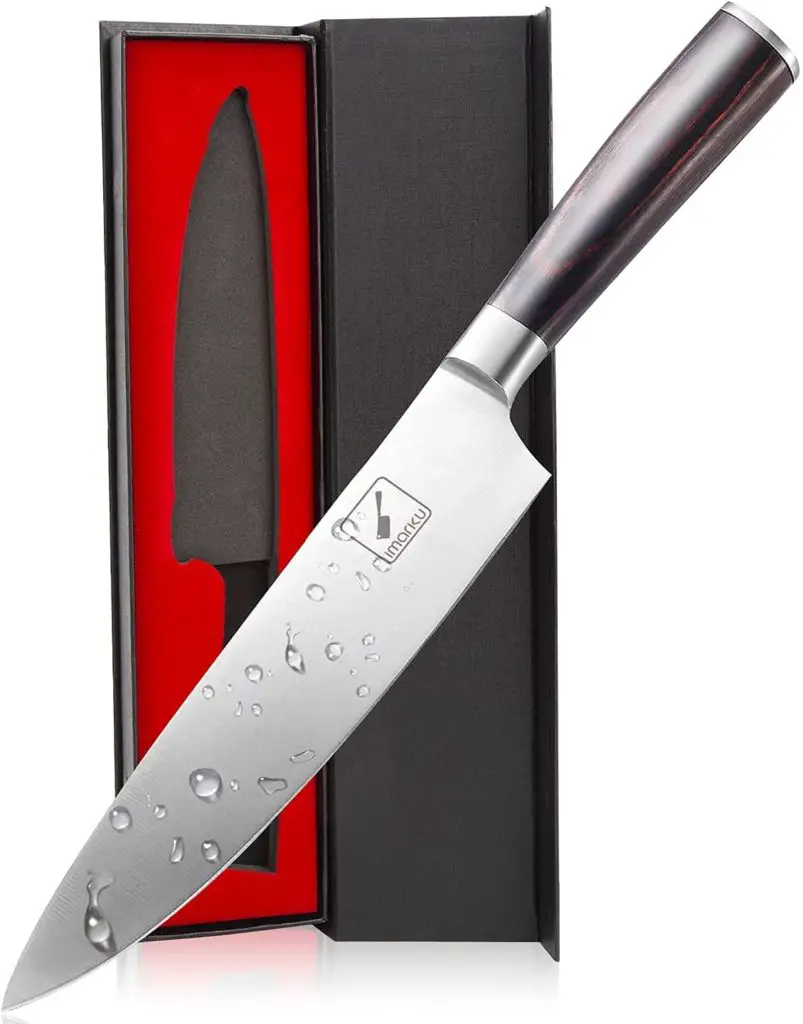
Originally generated in 1839 in Solingen Germany, this best chef knife is simply stylish, aesthetically pleasing, and is a perfect blend of best appearance and functionality. It is lightweight than most of the knives, despite having a hard blade, making your cutting task easier, faster and less tiring!
This best kitchen knife possess high carbon steel blade i.e. 7Cr17Mov High-Carbon Stainless steel with 0.6-0.75% carbon for hardness and 16% – 18% chrome making it 2 times harder than normal knives that have around 0.3% carbon and helps for a long time use without rusting or tarnishing.
It is a multi-purpose knife, usable for almost every professional cutting application like slices, dices, chops, and also for the removal of flesh from bones.
It has an ergonomic 5-inch handle with the blade to make it more professional and prevent any aches, numbness, or pain in the fingers by using it for a long time. The Pakkawood is used in the making of this best chef knife’s handle with an engraved end cap and offers plenty of knuckle space. The Pakkawood from Africa is known worldwide for its comfort, firmness, and strength. It is resin-treated and thus resistant to water.
Imarku chef knife has an ultra-sharp blade edge which is perfect to obtain seamlessly sliced vegetables, chops, dice and it remains the same even when removing hard flesh from bones or cutting tough meat. The addition of 16-18% chrome in the blade composition gives it a glossy finish and prevents corrosion in the future hence making your best chef knife durable and long-lasting. Its edge has a double-beveled blade with a 15° angle. In addition to that, the latest German technology further modifies the blade of this best kitchen knife. So that you have the best experience of cutting foods in your kitchen!
Pros:
- The chrome addition makes the knife durable and prevents rusting or tarnish.
- Pakkawood handle is very comfortable.
- Ultra-sharp blade makes fine and perfect cuts, sluices and chops
- The glossy finish and red-velvet packaging is perfect to give this knife as a birthday present
- Lightweight and easy to handle as compared to heavy knives.
- 100% money-back guarantte
Cons:
- Not suitable for cutting frozen food or heavy chopping.
J.A. Henkel’s 8 Inch International Classic Chef Knife:
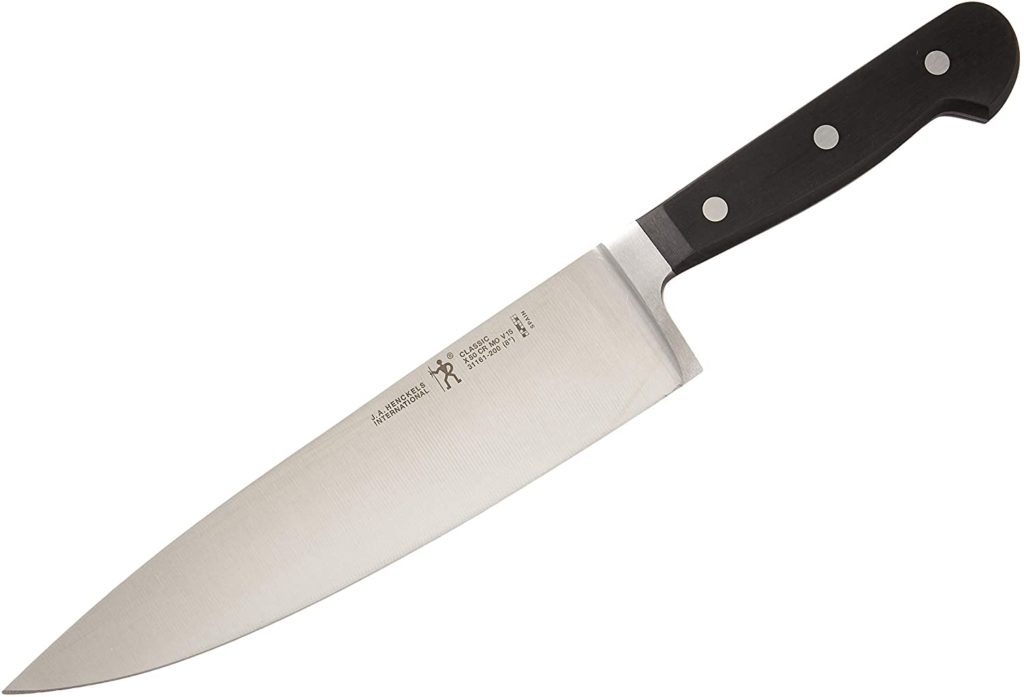
This best kitchen knife originally manufactured in Spain is well-known and common for its multi-purpose professional cutting and chopping by restaurant chefs and cooks. There’s no surprise that J.A. Henkel’s German kitchen knives are a favorite of world-class chef Gordon Ramsey.
The blade of J. A Henkel’s knife’s blade has special German high-carbon stainless steel in manufacturing. Its hot-drop forged blade grounds in two directions to create a 15-degree edge. This feature is vitally important for durable and tarnish-free knives so that you can cut, chop, slice or dice almost every kind of food for a longer period without the fear of blade damage and corrosion.
The fully forged blade with a seamless transition from handle to the blade makes it more durable and strong to cut heavy flesh. Outside the seamless handle, it has an outer ergonomic covering made up of polyoxymethylene comprised of two scales that attach to the full tang with 3 rivets. The edges ground down to create a smooth edge and give the appearance of a single piece. This handle is very long-lasting, balanced and comfortable to use.
Check out our comparison of Chicago Cutlery vs Henckels
Further furnished with Satin, the blade of this Zwilling knife improves the level of precision cutting and long-lasting sharpness of the edge. According to a review survey, most people found this knife very comfortable to use because of its perfect balance and sharpness. Also, it is the perfect recipe for multi-tasking and your budget stability.
Instead of half-blade and half-handle things like other ordinary knives, it has a full bolster which provides weight and balance to the knife making it easier for you to hold it strongly and perform heavy cutting tasks. The bolster also protects your hands from the sharp blade.
Check out our article on Wusthof vs Zwilling JA Henckels
Pros:
- The perfect weighing scale of handle and blade length.
- Multi-purpose knife for every heavy and light cutting.
- Full bolster ensures hands are safe and comfortable to use.
- Dishwasher safe.
- The satin finish gives fine cutting and long-lasting sharpness.
- High-quality German stainless steel ensures a rust-free blade for a lifetime.
- The Triple-rivet handle is less tiring and easier to use.
Cons:
- May require a blade sharpener after some time of use.
- Some vegetables’ skin clings to the blade after cutting them.
Check out our full Review on Henckel Knives
WÜSTHOF Gourmet Two Piece Cook’s Knife Set:

Are you looking for the best knife sets, including one with a small blade and the other with a larger one together within your small budget of $100? Here you have the best opportunity to buy WÜSTHOF Gourmet Two Piece Cook’s Knife Set which is perfect for your every kitchen cutting task! WÜSTHOF Company found in Solingen, Germany manufactures the best quality products as it carries the firmest quality standards in cutlery.
The WÜSTHOF Gourmet Two Piece Cook’s Knife Set includes a 4-inch utility knife and an 8-inch chef knife, the sizes are precise and most appropriate to pair with as one of them helps to do small peeling and slicing tasks while the other one helps you in heavier or larger cutting and chopping purposes.
Check out our article on Santoku vs Chef Knife
The blade of this best chef knife set has high carbon stainless German steel stamped with the latest laser-cut technology for an exceedingly incredible sharpness of the edge. They are stain-resistant and durable. While the edge inclines to 14 degrees, the ultra-sharp blade of this best chef knife set is perfect for precise cutting, chopping, slicing, mincing, and dicing.
This best chef knife set has triple-riveted handles with a full tang for a more comfortable and strong grip of your hand and makes it easier to use. The handle is made up of polypropylene. It resists heat, fading, and bruising.
The WÜSTHOF Gourmet Two Piece Cook’s Knife Set offers you two kitchen knives of different sizes instead of one for, and both of them are equally helpful for your kitchen tasks. The blades of these knives are buffed and polished with hands. That’s why we highly recommend you this best chef knife set!
Also Check out our article on Wusthof vs Shun Cutlery
Pros:
- The large blade of this chef knife with pointer edge is perfect if you want professional cutting
- The stainless steel blades provide you best performance and durability.
- A triple riveted handle offers a comfortable and strong grip on your hand.
- You can use the smaller knife for peeling or slicing and the bigger one for heavy jobs.
- The handle is heat-resistant and the colour of the handle doesn’t fade with time.
- Full tang on the blade provides balance and strength to your knife for precise cutting.
Cons:
- Only hand-wash recommended
- Avoid using for meat removal from hard bones.
Check out our article on Cutco vs Wusthof
Mercer Culinary Genesis 6-Inch Knife:
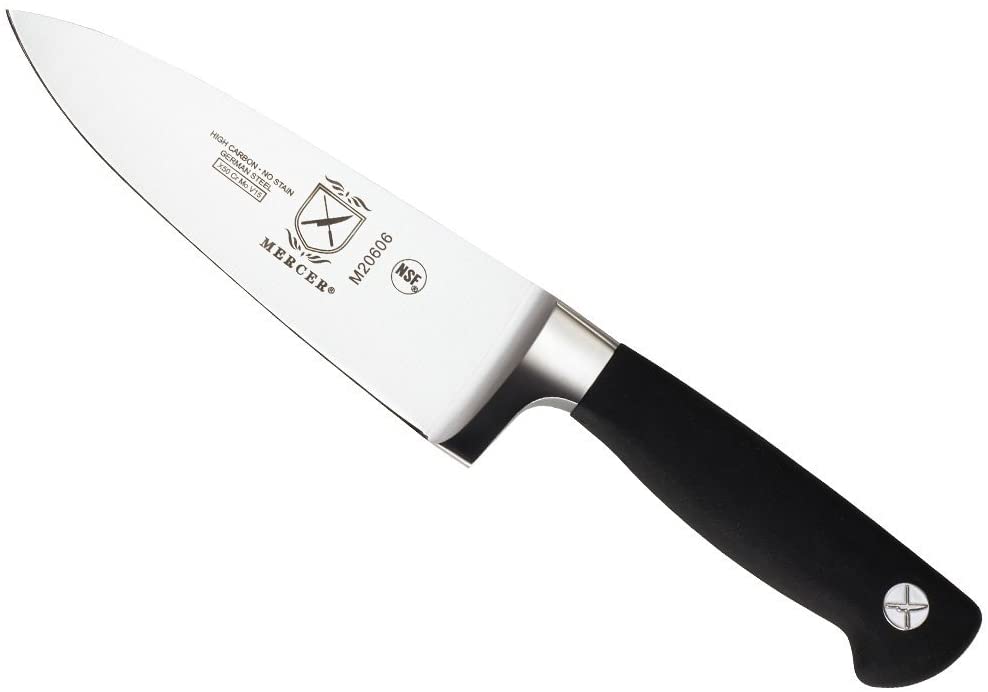
The Mercer Culinary Genesis 6-Inch Chef’s Knife whose budget is under 100 but possesses the qualities of most expensive kitchen knives, is perfect for your kitchen use!
Its blade has high-quality German stainless steel in manufacturing. It resists heat and rust to the utmost level. This is why this best chef knife stands out with the most expensive knives in price and quality. If you want the best chef knife with durability and functioning, we highly recommend you Mercer Culinary Chef’s Knife.
The edge of this best chef knife’s blade taper-grounds to provide thorough cutting action in a finer and precise way. Because it penetrates through the food easily giving you finer slices with increased efficiency and long-lasting sharpness. And you can easily cut, slice, chop, mince, or dice with this single piece of the knife.
Just as the edge of this blade improves cutting performance, the same is the same in its handle. The full tang on the blade provides balance and strength to the knife making it easier for you to handle it and perform heavy cutting tasks without any damage. The ergonomic Santoprene handle gives your hand an extra-strong grip without tiring your fingers instead of many ordinary wooden handles. Your hands won’t slip! Your fingers won’t feel numb or hot as this synthetic handle is heat-resistant! Another best thing about this handle is it won’t break like wooden ones and it is the best option for extended use.
This best chef knife is also NSF certified which means it meets the standards of professional cutting and is ready to use in any professional kitchen around the world. So if you want this best chef knife in your kitchen, Order below now!
Pros:
- A perfect balance of blade and handle length
- Comfortable and easy to hold the handle
- The blade is sharp and pointed enough for professional cutting.
- Affordable price with high-quality steel
- Stain and rust-free blade
- Multi-purpose knife
- NSF certified
- Dishwasher safe
Cons:
- Extremely sharp blade, not recommended for beginners.
Victorinox Fibrox Pro 8-inch Knife:
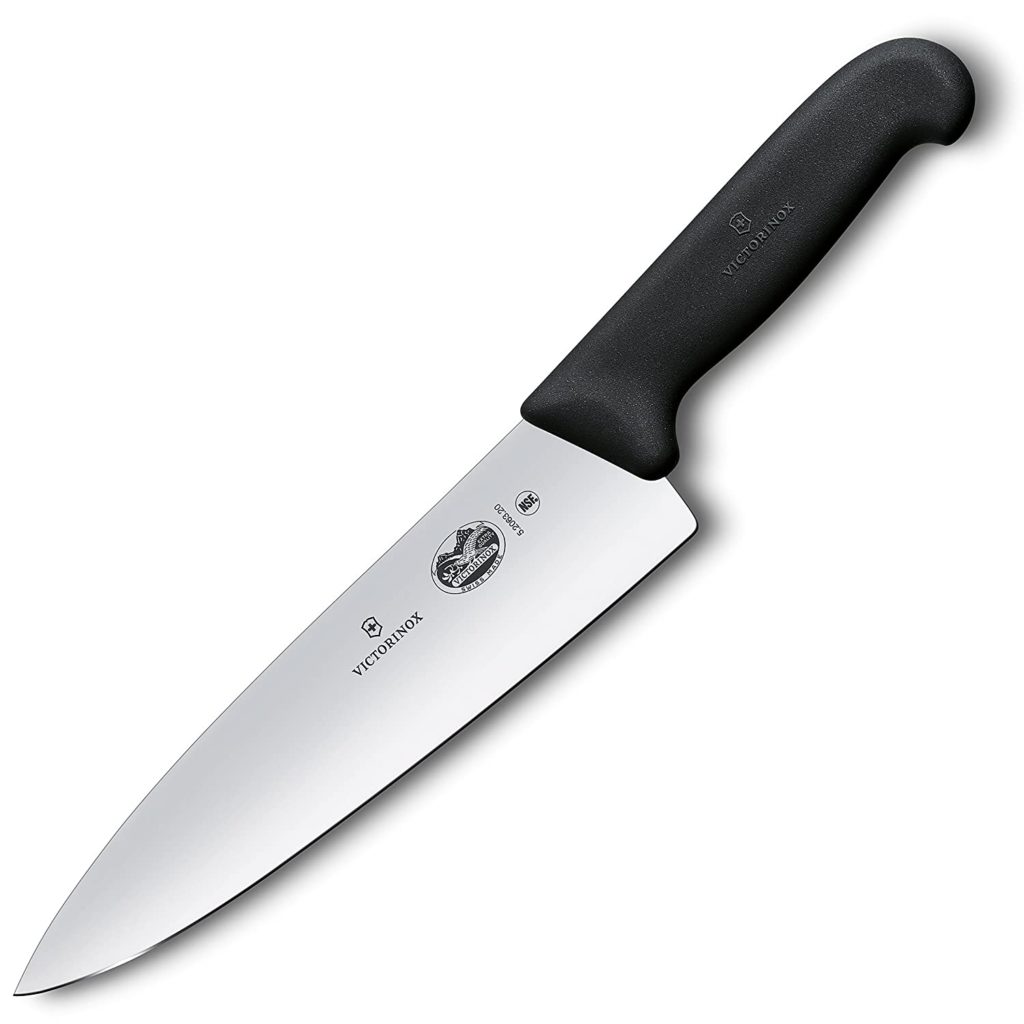
Victorinox Fibrox 6-inch chef knife is one of the most common picks among best chef knives. When we tested its performance and features to see what dignifies it from other kitchen knives, the results didn’t disappoint us at all! Everything about this best chef knife convinces you to choose this masterpiece kitchen tool!
Made up of high carbon stainless steel from Switzerland, it has a super-sharp blade with a curved edge that performs excellent cutting and heavy chopping with perfection and it is rust and stain-free. The unique thing about this chef knife is its blade width.
The blade is quite wider than normal knives but less than a meat cleaver. This means you can quickly slide all your chopped food with a knife to a dish. Or you can easily smash a garlic clove with one move.
Also, the blade has stamped blade rather than forged. But no worries! Although stamped knives are usually lightweight and less durable. But this one is a high quality stamped-knife! As we tested it for slicing and chopping vegetables and also cutting bread edges which sometimes require a serrated knife, but its straight blade gave fine and perfect slices without any effort.
As much as you can use this blade for cutting or chopping vegetables. It could also cut fine slices of meat without any hurdle and It amazed us so much! Furthermore, the price of this knife is butter on bacon.
Not just the wide unique blade, its handle is also different from other knives. It has a rough sheath outside which looked difficult to use to us. But when we performed our cutting, it made the knife so slip-free and comfortable that we forgot about the texture and its surface. The thermoplastic handle provides enough balance and resistance to your hands from slipping instead of being lightweight.
Although the knife is extremely sharp in the beginning, it may require sharpening with time if over-used. There’s not much that this best chef knife can’t perform. So if you have a small budget, we recommend you Victorinox Fibrox 6-inch chef knife.
Pros:
- Lightweight and comfortable to use
- The handle is rough and provides a strong grip without slipping
- The blade is extremely sharp and extra wide
- Swiss blade is stain-free and doesn’t corrode
- Perfect for light cutting purposes
- Affordable price with high quality
- Dishwasher safe
Cons:
- Stamped blade is not recommended for heavy cutting
- Peel cling to the rough handle after cutting
DALSTRONG 8″ inch – Gladiator Series:
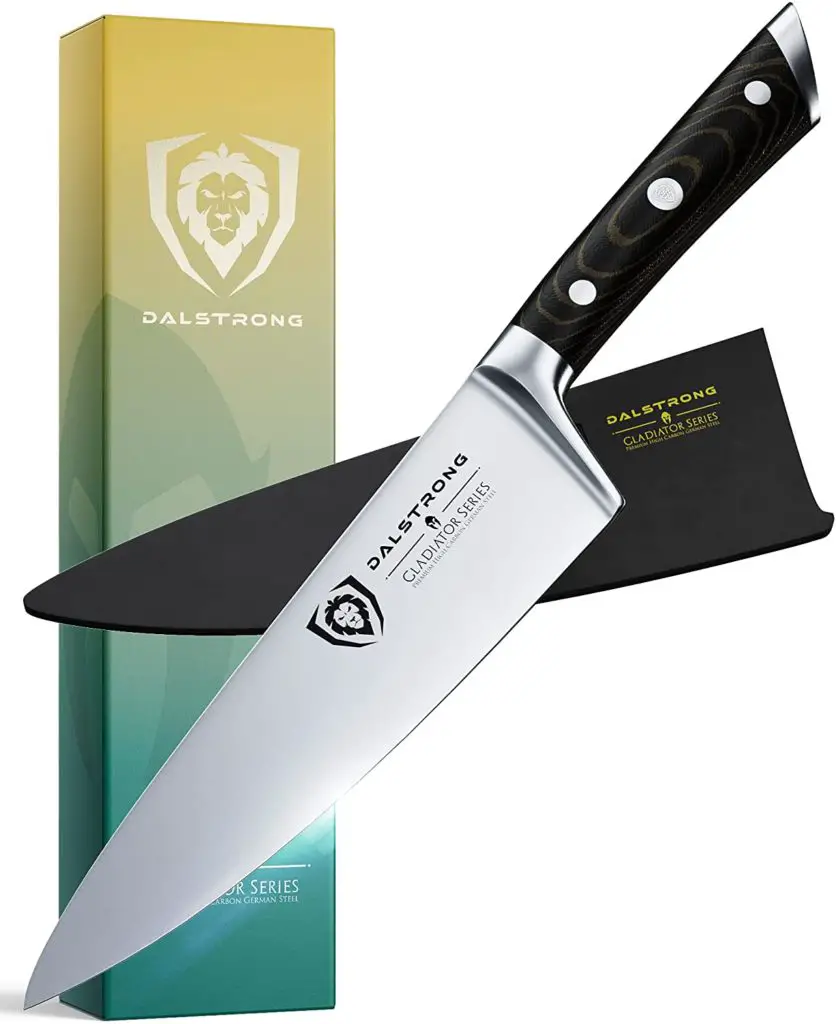
When we tested several brands to look out for the best chef knives, Dalstrong Gladiator Series came out to be the most prominent and best one out of all of them. Read our full review on Dalstrong Knives
Excellent blade quality, handle and sharpness of this best chef knife impressed us so much that we decided to test and use this knife how effective it performs and here’s what we found out! Read
Considering the budget which is important for almost everyone to choose the best, high-quality, and cheapest kitchen knife, we concluded that Dalstrong knives is the best option for everyone. No matter if you are a restaurant chef or a home cook, this best chef knife will perfectly perform every cutting task including chopping, slicing, mincing and dicing too.
Although we can use some knives for almost every task. But their performance is not high in any of the cutting task, surprisingly this knife is amazing with being perfect to cut or slice any food without any hurdle! The multi-purpose quality of this knife is because of so many unique features including a large blade and extremely sharp edge with a full tang bolster handle. Let’s take a look at them.
The steel of this blade is of excellent quality, imported from Germany. It is high-carbon ThyssenKrupp stainless steel with more than 58 Rockwell hardness that makes it stain-proof and rust free. So that you can use this best kitchen for extended use. Furthermore, a hand polish of the Satin finish on the edge makes your knife, durable and long-lasting. Not to mention, the design of this knife is stylish and so elegant. We cannot deny that this best chef knife is a perfect blend of beauty and quality with affordable price.
Just like the excellent blade quality, its handle also stands out unique in all other ordinary knives with a high price. Made up of a triple-rivet and full bolster, it provides strong grip and full balance to your hand. And protects your fingers from any injury. As beautiful and elegant it looks, this knife is comfortable to hold and even perform heavy cutting jobs without tiring your fingers.
The handle is also water and stain-resistant, protected with BPA free Dalstrong sheath making your knife durable and lifelong. This ergonomic handle with the ultra-sharp blade gives an excellent experience of cutting vegetables, slicing fruits, mincing meat or removing hard flesh from bones.
Another specialty about this best chef knife is that it is NSF certified and is ready for professional use in any kitchen all around the world. Not just that, Dalstrong Gladiator Series design is also best knife design and performance award holder!
So if you want a budget friendly knife with perfect appearance and high-quality, don’t waste your time anymore and place order below now!
Pros:
- This knife has excellent sharp blade length and edge for professional cutting
- Triple-rivet handle is easy and comfortable to hold
- Multi-purpose knife
- Dalstrong Perfect-fit sheath for long-lasting handle
- Full tang on blade provide weight and balance to your hands
- High-carbon German steel with Satin finish resists stains and corrosion
- Award-winning design
- Stylish and elegant in appearance
- Affordable price with best quality
Cons:
- Knife size is a little large for small hands
- Extremely sharp blade, extra care needed while using
Zelite Infinity 6 Inch Knife – Alpha-Royal Series:

If you ask us to define this best chef knife in one word, we call it VERSATILE! Yes, Zelite Infinity 6 Inch Chef Knife has every element of perfect kitchen knife one can ask for. We realize that everyone wants the best quality with the lowest price. When we tested this best chef knife, each and every feature of this best kitchen knife amazed us! Going from the blade’s length and quality to the handle’s balance and a strong grip to its premium packaging in a velvet box, this knife has impressed customers with a lower price tag.
This knife is designed to be used by professional chefs and home cooks alike. This best chef knife may look like any other big, bulky chef knife, but it’s nearly weightless and ergonomically designed to make it easy to handle. The sharp blade of the knife cuts through raw chicken and other meats with ease, making it ideal for meats as well as vegetables. Whether you’re chopping onions, carving a roast chicken, mincing beef or slicing fruits. This knife will complete the job right away!.
The 6-inch blade of this best chef knife is easy to use and handle. This is originally a Chinese chef knife, imported from Japan. 67-layer high carbon stainless- steel is used in the making of this best chef knife. It makes the knife stain and rust-free. Furthermore, the blade is treated with liquid nitro-cooling. Which gives this knife an incredible level of HRC 61 Rockwell hardness. The edge of this best chef knife is inclined to 12 degrees and a Tsunami Rose Damascus Pattern is installed on the blade which makes it super sharp and stylish in appearance.
Just like an extraordinary blade, the handle of this best chef knife is also excellent in quality and comfortable to use. This knife is forged rather than stamped which makes it heavy and more balanced. The Top Military Grade G10 Black ergonomic Handle is triple-riveted with a full tang on the blade which provides excellent grip and is less tiring to work for extended use. Your hands feel balanced and you can cut heavy pieces with less effort and more efficiency. The handle is further rounded to the edge to ensure a more comfortable and secure grip.
The best thing about the Zelite Infinity Chef Knife series is its lifetime warranty against manufacturing defects! If you find this knife not suitable for you, you can even have your money back! But we are sure once you buy it, you’ll love it. This best chef knife is beautifully packed in a red velvet box, a perfect present on birthdays, weddings or Christmas for your friends and family! So if you want this best chef knife to be a part of your best kitchen tools, place the order below now!
Pros:
- Stainless high-carbon blade is long-lasting and durable
- 6-inch blade length easy to handle and control
- Super sharp blade edge for fast and efficient cutting
- The knife can used for any cutting purpose
- Triple-rivet ergonomic handle provides a strong grip and balance to your hands
- Stylish and chic in appearance
- Wide blade for perfect chopping
- Beautiful packaging in a velvet box
- Money back guaranty
Cons:
- Hand wash only
- May need sharpening after some time of use
Types of Knives:
let’s review which knives are usually used in the kitchen according to specific needs.
Besides the luxury knives, there are three types of knives.
- A Peeling Knife
- A Saw-edged Knife
- And a Chef’s Knife.
Peeling Knife:
A peeling knife peels off the skin of fruits, vegetables with its sharp blade usually 3 to 4.5 inches long. It has a rigid blade with an easy-to-hold handle that prevents sliding off the skin and peels off easier and faster.
Saw-edged Knife:
A saw-edged knife, also known as a serrated knife, is useful in cutting loaves of bread, tomatoes or cucumber, etc. It is best to cut foods with a hard crust and soft cores just like bread. With its 8-9 inches long tooth-edged blade, it locks with the outer hard part and cuts off smoothly. So you can call it a bread knife too!
Chef’s Knife:
The third type is the chef’s knife and it is the most important part of any kitchen. In cooking, a chef’s knife, also known as a cook’s knife, is used for chopping, cutting, peeling and almost everything you want to cut off. Although it was specifically designed to cut off beef loaves but today, it is widely used by western cooks for general purposes.
Check out our article on Santoku vs Gyuto Knife
Traditional Chinese Cleaver:
A Traditional Chinese Cleaver has a big rectangular heavy sharp blade about 8-10 inches long that is used to slice meat and disjoint large cuts. The Japanese Sankuto Chef’s knife has a flat edge blade that curves down at the tip. Similarly, the German-style Chef’s knife is deeply curved along the whole cutting edge. It is used for cutting, dicing and mincing of meat; the French-style Chef’s knife has an edge that curves up to the tip.
Other than that,
Carving Knife:
A carving knife or a slicing knife has a long blade with a sharp pointed edge used for slicing and carving dense meats. It is used to cut thinner slices of roast, fruit and vegetables. Its narrow width means that it produces less drag as it cuts through food, allowing it to create cleaner, more uniform slices.
Boning Knife:
A boning knife is best to remove bones of meat and trimming cartilage of poultry, fish, etc. It has a thin narrow blade with a sharp point generally 5-6 inches long which perfectly cuts off the bones from meat. However, flexible bony knives are more preferably used in poultry and fish.
Check out our article on Best Steak Knives
Nakiri Knives:
A smaller version of Chinese Cleaver, also called Nakiri knives is widely used by professionals for cutting and chopping vegetables. They have a much thinner straight blade edge than Classical Butcher to chop the vegetables finely without breaking the slices.
Check out our article on Kiritsuke vs Chef knife
What To Look For In Buying The Best Kitchen Knives:
There is a huge variety of best kitchen knives that are affordable and lie in your budget BUT many of them are junk and do not fit in quality and durability.
Below are some important factors needed to be considered before buying a good kitchen knife.
Blade length and weight:
Normally, the most feasible size of chef knives used by people is 6-8 inches long. Our researches showed that the best size of affordable chef knives recommended by many writers was an 8” lightweight blade. The blade should also be light at the tip; a thick tip will be hard to work with.
However, we also picked the best full-sized chef knives available for you on special demands to save your money and time.
Quality of blade steel:
High-carbon stainless steel alloys are used in knives’ blades for better strength and toughness. They won’t rust over time, like ordinary carbon steel can. Usually, the German and Japanese chef knives have the best quality steel used in their blades. These are very rare knives that are made of high-quality steel.
After detailed research, we have listed the quality of steel used in our best-picked chef knives so that you easily distinguish which knife would be the most suitable for your use.
Warranty:
A lifetime warranty given by a company automatically indicates the good quality of their manufactured product. Of course, if you are spending your $$$ to buy the best chef knives, it is important to consider if the cutlery set you are purchasing has a proper warranty or not. Because, if these kitchen knives are used with little care, your $$$ can become a lifetime investment without any loss.
